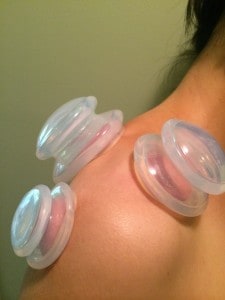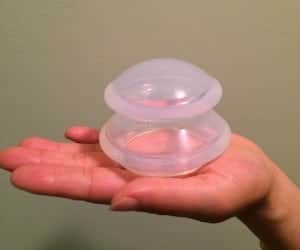Anyone who has experienced the deep relief from muscle tension that cupping provides knows about the transformative affect of decompression on tissues that seem to have shrunken and contorted themselves into a puzzle of knots and contraction. The traditional Chinese glass fire cups work really well on the more meaty areas of the body. But, they don’t navigate as well around bony protuberances, and they just can’t get a grip in areas that are mostly sinew, tendon or connective tissue.
This is why we are excited about using the new silicone cups we have at Yong Kang Clinic!
 Due to their flexible nature, these cups can sidle right into those creases and crevices between the tendon, bone and muscle and release long-gathered accumulations that show up as knots, nodules or wiry, ropy tendons. It’s like finally being able to scratch an unreachable itch.
Due to their flexible nature, these cups can sidle right into those creases and crevices between the tendon, bone and muscle and release long-gathered accumulations that show up as knots, nodules or wiry, ropy tendons. It’s like finally being able to scratch an unreachable itch.
The interesting thing I’ve found about using the silicone cups (they actually look more like flying saucers or a Lego version of Beijing’s Temple of Heaven) is that they seem to have a real affinity for the fascia, or connective tissue of the body.
So we’ll go with the glass cups if your problem lies in the musculature, but if the problem is more in the fascia or in the connections between bone and sinew, then the silicone cups are the tool of choice.
The “why” of the silicone cups
Partly it is a matter of resonance. The softer material of the cup matches more closely to the soft, flexible nature of the connective tissue. Because these cups change their shape as they are slid, they tend to engage in a profound way at the level of the connective tissue. Plus, it is possible to feel the condition of the underlying tissue. These cups seem to amplify abnormalities in the tissue as the flexible cups are slid over problem areas.
You know the difference in feel between an old, crinkly, dried-out rubber band and a smooth, new elastic one? It’s a similar thing with the fascia. Healthy connective tissue should be smooth and a bit slippery. Tissue that has been deprived of movement and nourishment gets tight, dry, a bit shortened and corrugated in feel. By nature, this connective tissue is not well vasculated, and when the area gets tight, the minimal blood flow to the area becomes even more restricted.
The silicone cups both bring blood into the connective tissue and help to stretch out collagen fibers that have become shortened. A treatment brings new blood and nutrients to the area, mobilizes and removes stagnant blood and tissue and takes that contracted fascia and gently stretches it out to its proper dimension. Plus the cups can decompress the tissue in hard-to-reach places, dissolving knots and nodules.
In clinic I’ve seen cases where the silicone cups literally “iron out” the fascia and remodel it!
 What problems can be treated with the silicone cups?
What problems can be treated with the silicone cups?
• Occipital pain and headaches
• Shoulder and neck tension
• Pains wedged into the scapula
• Adhesions and lumpy tissue following liposuction or laparoscopic surgery
• TMJ
• Cellulite
• Knee pain
• Foot pain
• Tennis or golfer’s elbow
• Plantar fasciitis
• Scars
Can I get a cupping session that uses both the glass fire cups and these new-fangled silicone cups?
Absolutely! There are plenty of situations where using both methods brings even better results. And yes, cupping and acupuncture go quite well together.
A 15-minute session of cupping costs $20, unless you add it onto your acupuncture treatment, in which case it is $15. We also offer a half-hour session for $30. Simply call for an appointment or use the online scheduler.
